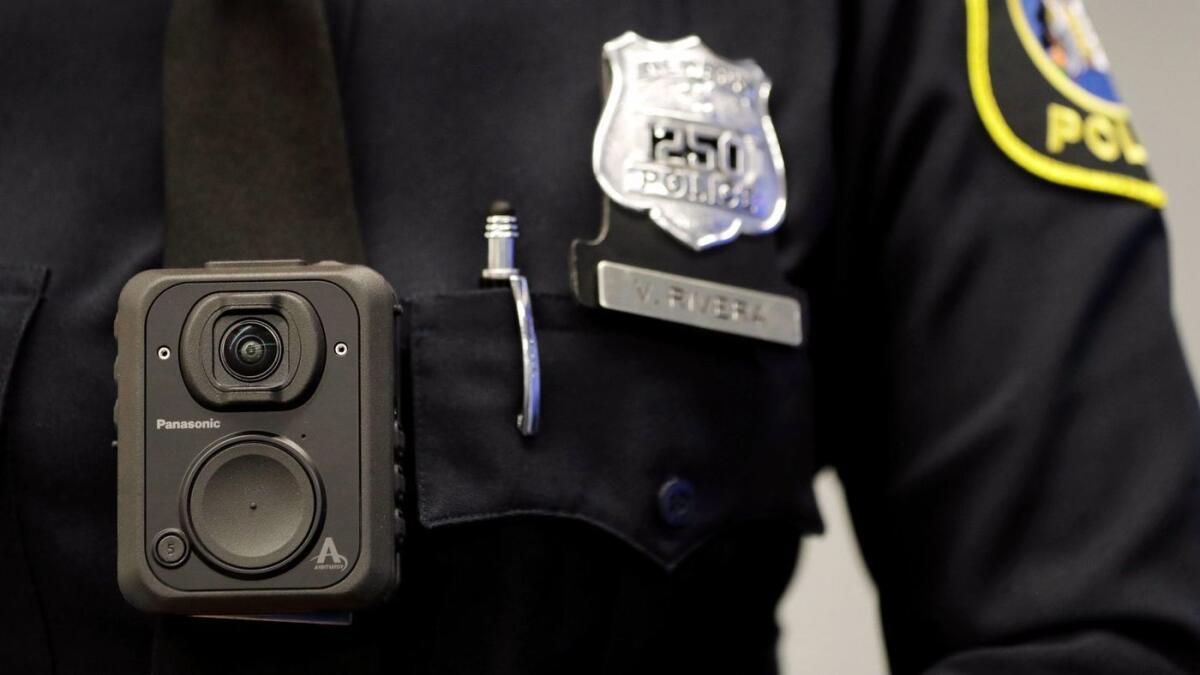Editorial: Release of police video ought to be simple and quick

- Share via
In the wake of angry, traffic-blocking protests, the mayor and police chief of St. Paul, Minn., have promised the quick release of video images captured by body cameras worn by two officers involved in the fatal shooting Sunday of William “Billy” James Hughes. It’s the right move, but prompt release of video in such incidents ought to be automatic and not dependent on the volume of protests or the pressure felt by public officials.
Fatal police shootings are now far more widely known and discussed than in the past, in part because of activism and protests, but also because of the prevalence of video-capable phones among the public and body cameras worn by police. Video images provide an incomplete yet essential view of critical incidents, and in the aggregate they give the public a better understanding of police work. Quickly releasing body camera video can help enhance public trust in police. Delays can do the opposite.
And releasing video only after public outcry sends the message that police responsiveness and transparency should come only upon demand and not as a matter of course.
A growing number of the nation’s roughly 15,000 local law enforcement agencies, including the St. Paul and Los Angeles police departments, now use body cameras. In March, the Los Angeles Police Commission adopted a policy of releasing video recordings within 45 days of the incident. Automatic release (except in the case of extenuating circumstances) is an improvement over the previous approach, under which video was released if and when it suited the department.
Quickly releasing body camera video can help enhance public trust in police. Delays can do the opposite.
Under the new policy, the Los Angeles Police Department has now released nine video recordings of critical incidents, including one on Saturday that shows a June 20 shooting in Porter Ranch. Late last month it released a recording of the accidental shooting of a hostage in Van Nuys. Also last month, it wisely — well in advance of the deadline and within days — released video of the high-profile Silver Lake Trader Joe’s incident in which police killed a hostage.
The 45-day grace period between the incident and video release is meant to ensure that no witnesses will be endangered and that prosecutions will not be undermined. Those are worthy goals. But the period is too long, and the editing that the LAPD does — to give the public a better understanding of what is being depicted, police say — may actually undermine confidence in police transparency if they are not also accompanied by the full, unedited video.
So far, though, the release policy has worked as it should and is one factor in moving the LAPD from one of the nation’s least transparent police agencies to one of the better ones.
At the back of the pack is the Los Angeles County Sheriff’s Department, which still has neither body cameras nor a video release policy. That puts it behind numerous jurisdictions, large and small, including St. Paul, where police can now respond to demands for information over the Hughes shooting.
Or in Florida, where the Volusia County Sheriff’s Department released video of a fatal deputy-involved shooting on Friday.
Los Angeles County officials have been mulling a body camera program for years but haven’t gotten the job done. On Tuesday, the Board of Supervisors called for a study — although the county has already studied the issue extensively — and another five months to complete it.
Enter the Fray: First takes on the news of the minute from L.A. Times Opinion »
What’s really needed is a county budget allocation to get the body cameras on sheriff’s deputies as quickly as possible, and a sheriff’s policy governing public release.
L.A. County’s Sheriff Civilian Oversight Commission filed a report on July 26 that urges the county to move forward on body cameras and details the advantages, beyond informing the public of what happened during a critical police incident such as a fatal shooting. Members found that just knowing the cameras are there improves the behavior of both officers and the people they encounter. Fewer complaints are filed.
Video also is essential to criminal defendants — and to police officers — who are falsely accused. It’s also essential to plaintiffs seeking to vindicate their civil rights.
Some privacy activists and police critics assert that body cameras are part of a program of surveillance and criminalization, especially of nonwhite communities. But that’s why it’s not enough to have the cameras. They must be governed by a carefully crafted and enforceable policy. They have done it at the LAPD and in St. Paul, and at thousands of other law enforcement agencies. They ought to be able to do it in Los Angeles County as well.
Follow the Opinion section on Twitter @latimesopinion and Facebook
More to Read
A cure for the common opinion
Get thought-provoking perspectives with our weekly newsletter.
You may occasionally receive promotional content from the Los Angeles Times.










